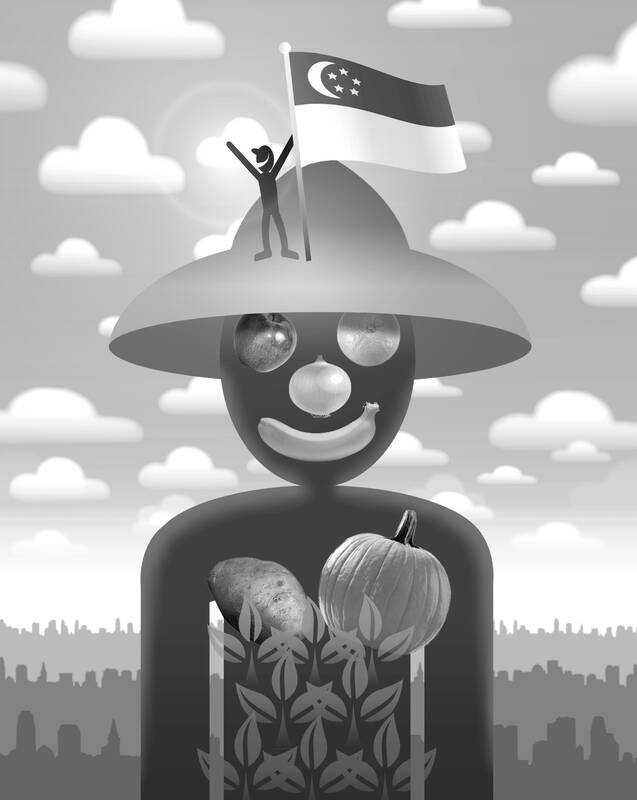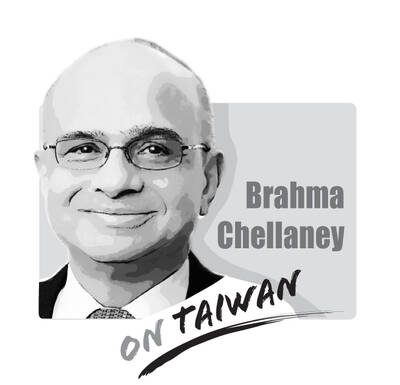By most measures, Karthik Rajan’s farm in Singapore is a success story. Run from a two-hectare plot of land in the island’s north, LivFresh has been supplying major supermarkets with spinach, lettuce and other Asian green vegetables since 2022. The firm turned profitable in March.
It might still close down by the end of the year.
Rajan is one of a small number of entrepreneurs attempting to farm in a country smaller than New York City. Like most of his peers, he is facing an uncertain future as funding runs dry, with investments in homegrown agricultural start-ups cratering over the past few years. Since the start of last year, at least half a dozen large farms have shut down or scaled back operations.

Illustration: Yusha
The result is a significant setback for the Singaporean government’s ambitious campaign to create a high-tech agricultural sector that can meaningfully reduce the country’s heavy reliance on food imports. In 2019, the Asian financial hub announced a plan to produce about one-third of its nutritional needs by the end of this decade — dubbed “30 by 30.” Now about halfway to the deadline, it is harvesting less than 10 percent of its seafood and vegetables, two out of three food sources closely tracked by officials.
“It’s a vicious cycle, because costs are currently high and avenues to scale are limited,” said Rajan, 46, a business consultant for nearly two decades before venturing into farming. Within the next six months, he must secure US$10 million in funding or exit the market.
“Investors get the sense that ‘30 by 30’ is dead,” he said.
Singapore’s experience, including its struggle with the limits of technology and a tiny domestic market, is becoming a cautionary tale for smaller nations hoping to improve food security at a time when geopolitical tensions and a changing climate pose a constant threat to supply chains. It has also exposed what urban farming can — and cannot — do.
The Singapore Food Agency said it acknowledges the challenges farmers face, including high operating costs and a lack of demand, but added that support was on offer.
The city-state’s land and sea-based farms have remained “relatively stable” at about 250 since 2019, the agency said in an e-mailed statement.
“The ‘30 by 30’ vision is a stretched ambition, but an important one,” said the agency, the main government body overseeing food security.
In Singapore’s race to develop after independence in 1965, soaring skyscrapers and sprawling housing projects sprang up, pushing out smallholders. As the financial hub grew in stature, the farming industry became collateral damage. Today, most of the sliver of land set aside for agriculture — about 1 percent of the total — has to be bid for and leased for just 20 years.
As a result, Singapore, with a densely packed population of nearly 6 million, imports the vast majority of its food, often across large distances. That leaves it more vulnerable when shocks such as global pandemics or natural disasters disrupt transportation or reduce food supply elsewhere.
The government has made no secret of the problem — a mismatch between space and demand. It planned to lean on technology to close the gap. A S$309 million (US$230 million) research fund created in 2019 to support “30 by 30” is dedicated to facilitating innovative farming solutions. Another S$60 million fund launched in 2021 aims to help farms with technology and expansion — although less than half of that sum had been awarded as of end April.
For Singapore’s farmers, though, tech-focused funding cannot solve far more practical problems.
“Running a farm here is barely sustainable,” said Kai Wong, who rears fish from wooden platforms off Singapore’s coast. “If you have no output, it’s impossible to start inventing and implementing new tech.”
To boost demand for his produce and ensure his fish is used, Wong had to expand beyond farming, setting up a restaurant and seafood soup stall.
A global plunge in private funding has weighed heavily, helping to drag the value of deals in Singapore’s food and agriculture technology sector down almost 90 percent from a peak in 2021 to just US$187 million last year, data from venture capital firm AgFunder showed.
Apollo Aquaculture Group, touted as Singapore’s tallest fish farm and backed by Temasek Holdings Pte, is now under judicial management. Sustenir, a vertical vegetable farm that is also backed by the heavyweight institutional investor, is on track to be profitable in the next six months, the firm says — but only after years of losses.
The state-owned investor is not retreating from the sector, but opportunities have declined, Temasek International Pte deputy CEO Chia Song Hwee said.
All the while, Singapore’s red tape is adding to the pain, farmers and agricultural executives said.
David Tan, chief executive of agricultural engineering firm Netatech, estimates that in extreme cases approval from as many as 10 agencies is required to obtain a single farming license, saying the process can be “painful.”
Victoria Yoong, who founded Atlas Aquaculture with her husband in 2019, had to wait more than a year for a permit to sell groupers reared in their fish farm. The process took so long that their tanks ended up full of fish with oversized heads, twice the ideal weight and less desirable for buyers.
“How can I tell investors with confidence that it’s okay to do farming here?” she said. “We want to get the basics right here, but my own government doesn’t support me.”
Of course, the lack of progress in “30 by 30” is also in part due to Singapore’s success in diversifying its food supply, as part of the same national efforts to enhance resilience. As a major trading port, it has sourced food from across the world — from Turkish eggs to Spanish mutton. Add in cheap produce from neighboring nations and consumers are often spoiled for choice.
That means demand for pricier, locally grown food is weak, said Mark Lee, who had to close his rooftop farm last year. None of the major supermarkets in Singapore agreed to sell his produce, he said, with one advising him to repackage vegetables from Malaysia instead.
“No one wants to pay more,” Lee added.
Back at the farms clustered in northern Singapore, producers are focusing on finding ways to remain afloat. LivFresh’s Rajan let go five of its employees last year to cut costs and is utilizing just one-third of its land.
Atlas Aquaculture’s Yoong said she is considering moving operations to countries including Indonesia, Malaysia or Australia.
Setting up in Singapore was “the worst financial decision ever,” Yoong said. “Do I still want to be a farmer? Yes. Do I still want to be a farmer in Singapore? No.”
A response to my article (“Invite ‘will-bes,’ not has-beens,” Aug. 12, page 8) mischaracterizes my arguments, as well as a speech by former British prime minister Boris Johnson at the Ketagalan Forum in Taipei early last month. Tseng Yueh-ying (曾月英) in the response (“A misreading of Johnson’s speech,” Aug. 24, page 8) does not dispute that Johnson referred repeatedly to Taiwan as “a segment of the Chinese population,” but asserts that the phrase challenged Beijing by questioning whether parts of “the Chinese population” could be “differently Chinese.” This is essentially a confirmation of Beijing’s “one country, two systems” formulation, which says that

Taiwan stands at the epicenter of a seismic shift that will determine the Indo-Pacific’s future security architecture. Whether deterrence prevails or collapses will reverberate far beyond the Taiwan Strait, fundamentally reshaping global power dynamics. The stakes could not be higher. Today, Taipei confronts an unprecedented convergence of threats from an increasingly muscular China that has intensified its multidimensional pressure campaign. Beijing’s strategy is comprehensive: military intimidation, diplomatic isolation, economic coercion, and sophisticated influence operations designed to fracture Taiwan’s democratic society from within. This challenge is magnified by Taiwan’s internal political divisions, which extend to fundamental questions about the island’s identity and future
Media said that several pan-blue figures — among them former Chinese Nationalist Party (KMT) chairwoman Hung Hsiu-chu (洪秀柱), former KMT legislator Lee De-wei (李德維), former KMT Central Committee member Vincent Hsu (徐正文), New Party Chairman Wu Cheng-tien (吳成典), former New Party legislator Chou chuan (周荃) and New Party Deputy Secretary-General You Chih-pin (游智彬) — yesterday attended the Chinese Communist Party’s (CCP) military parade commemorating the 80th anniversary of the end of World War II. China’s Xinhua news agency reported that foreign leaders were present alongside Chinese President Xi Jinping (習近平), such as Russian President Vladimir Putin, North Korean leader Kim
Taiwan People’s Party (TPP) Chairman Huang Kuo-chang (黃國昌) is expected to be summoned by the Taipei City Police Department after a rally in Taipei on Saturday last week resulted in injuries to eight police officers. The Ministry of the Interior on Sunday said that police had collected evidence of obstruction of public officials and coercion by an estimated 1,000 “disorderly” demonstrators. The rally — led by Huang to mark one year since a raid by Taipei prosecutors on then-TPP chairman and former Taipei mayor Ko Wen-je (柯文哲) — might have contravened the Assembly and Parade Act (集會遊行法), as the organizers had